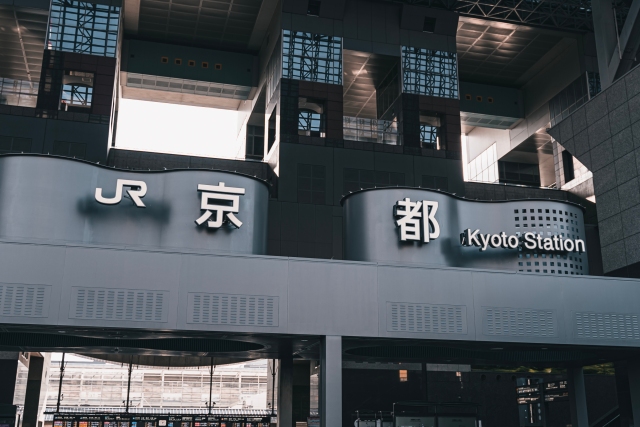
How true is the left-in-Tokyo, right-in-Kyoto standing rule?
There are plenty of differences that set the Kansai region, in and around Osaka, apart from the Kanto region, in and around Tokyo, and one of those differences is which side people stand on.
The difference in sides is most commonly seen when using escalators, with people in the Kansai area standing to the right and people in the Kanto area standing on the left. However, on a recent trip to Kyoto, our Tokyo-based reporter Egawa Tasuku found that this oft-spoken about standing etiquette isn’t as clear-cut as many assume it to be.
As soon as Egawa stepped off the train at Kyoto Station, he headed to the escalators, reminding himself to stand on the right when he got there, seeing as he was now in the Kansai region. However, when he glanced up at the line of people on the escalators, he found that…
▼ …they were all standing on the left, Tokyo-style.
People on the ascent and descent were both standing to the left, which Egawa wasn’t expecting, so he just stepped in line and followed suit. But then, after only a few minutes, he decided to return to the same set of escalators, and that’s when he found something even more peculiar.
▼ People on the up-escalator were still standing to the left, but people on the down-escalator were now standing to the right.
This was the first time in his life to see this type of standing arrangement, and making it even more bizarre was the ease with which it had changed in such a short amount of time. Nobody seemed fussed about it either, which made Egawa wonder if people in Kyoto were used to this fluid style.
Egawa continued his investigation, seeking out other escalators at the station, where he found that this one followed Kanto-style etiquette….
▼ …but this one close by conformed to the Kansai way of doing things.
As he travelled from floor to floor throughout the immediate area, he discovered that the escalator etiquette appeared to be a mix of east and west styles.
This certainly wasn’t what our Tokyo reporter had been expecting, as he’d grown up hearing the rules about standing to the right in the western region of Kansai. So when he got back to the office, he decided to ask his Kyoto-born colleague, Yuuichiro Waza, whether he’d noticed that the rules were actually more relaxed than rigid in his home city.
Yuuichiro, who, as the above photo shows, is generally more interested in the differences between steamed buns than the etiquette between Tokyo and Kyoto, said he’d never really paid much attention to what was happening on the escalators in his hometown.
However, after Egawa grilled him about it further, Yuuichiro gave the matter some more thought, and said:
“In Kyoto, like Osaka, there is the unwritten rule that you should stand on the right. However, Kyoto Station and Gion Shijo Station are frequented by a lot of tourists, so people from countries where it’s the norm to stand on the left will probably just naturally do that there.”
Egawa immediately piped up to challenge this point-of-view, saying that a lot of the people he’d seen standing on the left looked like locals, including young elementary school children, who obviously weren’t tourists.
Without missing a beat, Yuuichiro replied with:
“Kyoto people living in tourist areas may not know which side to stick to anymore because they’ve encountered so many people standing to the left. As a result, the culture of standing to the right may be gradually declining as left-standing culture infiltrates the area.”
Yuuichiro backed up his argument about rules being more relaxed in tourist areas by saying:
“In my hometown area of Kyoto, not a lot of tourists visit and almost 100-percent of people stand to the right.”
After chatting to Yuuichiro about it, Egawa realised that Kyoto Station and the surrounding downtown area is unlike a lot of other areas in Japan. It’s not just a place where traditional culture and architecture coincide with the modern — it’s a place where people from east and west Japan come into contact with each other frequently.
Because of that, it’s no wonder the culture and etiquette has become so mixed as well. While the region’s right-hand traditions still exist, it appears that locals will generally get in line behind the person in front of them, regardless of what side they’re standing on.
Egawa likes to respect and support local traditions, though, so he told Yuuichiro he would try his best to stand on the right when possible next time he visits the area, in the hopes that people will follow suit behind him. And he’ll remember another rule of etiquette that applies to escalators all around Japan — that walking up them is becoming more taboo.
Images © SoraNews24
● Want to hear about SoraNews24’s latest articles as soon as they’re published? Follow us on Facebook and Twitter!
[ Read in Japanese ]

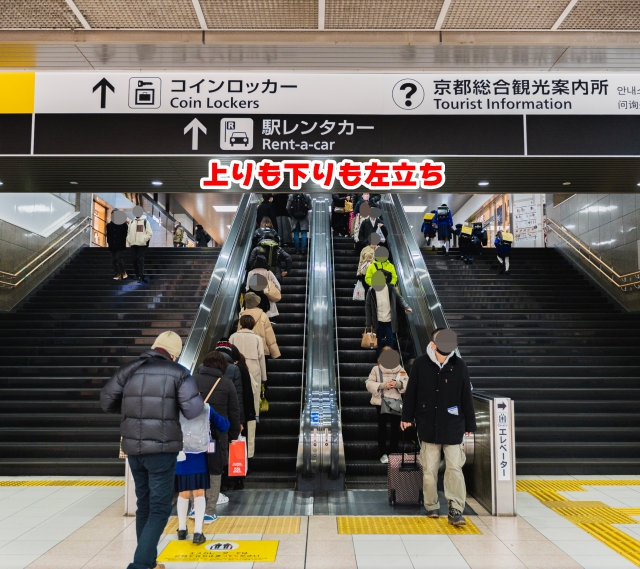
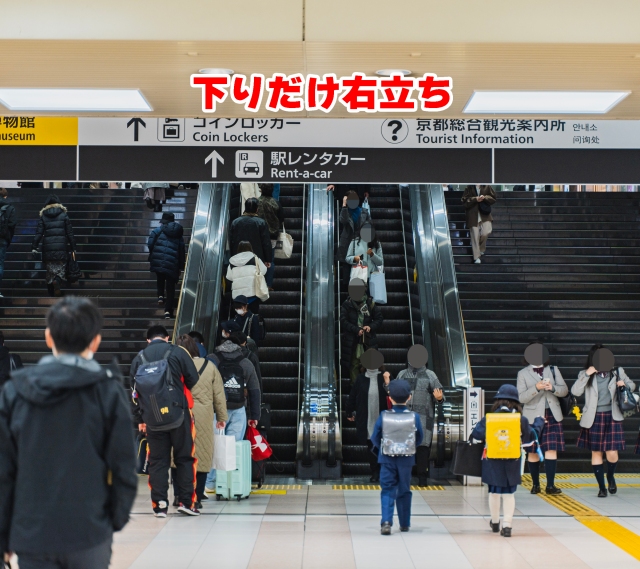
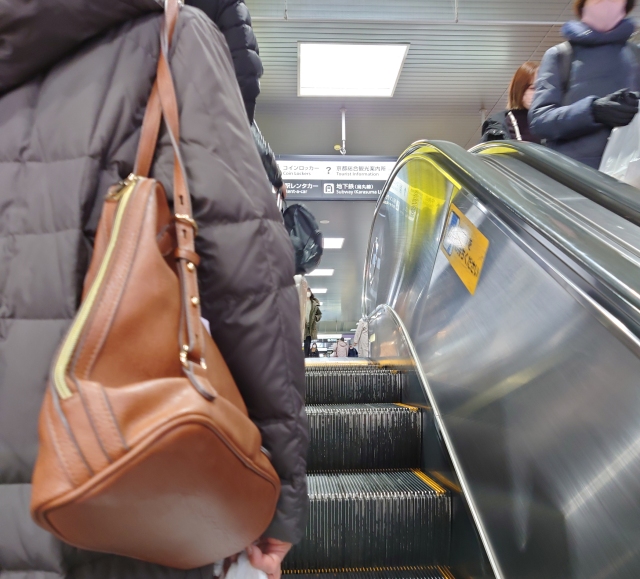
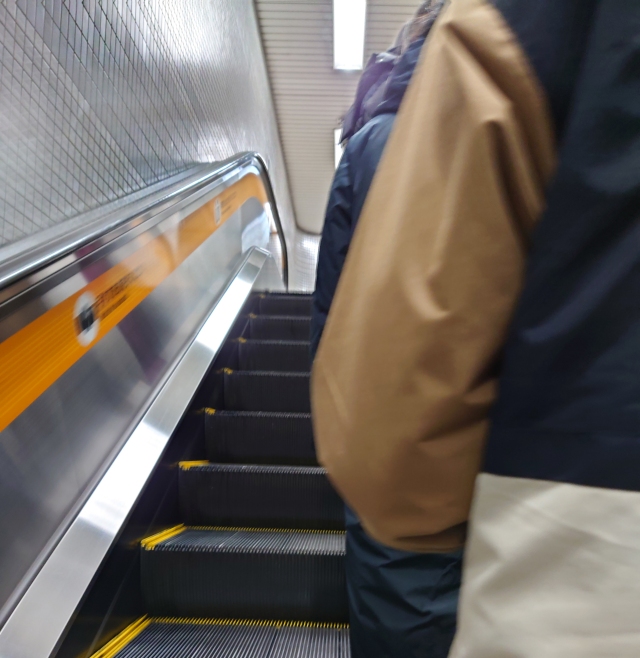
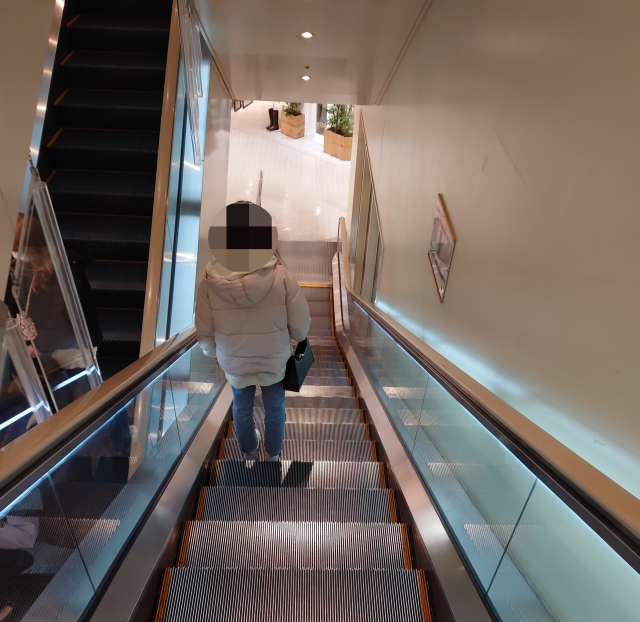
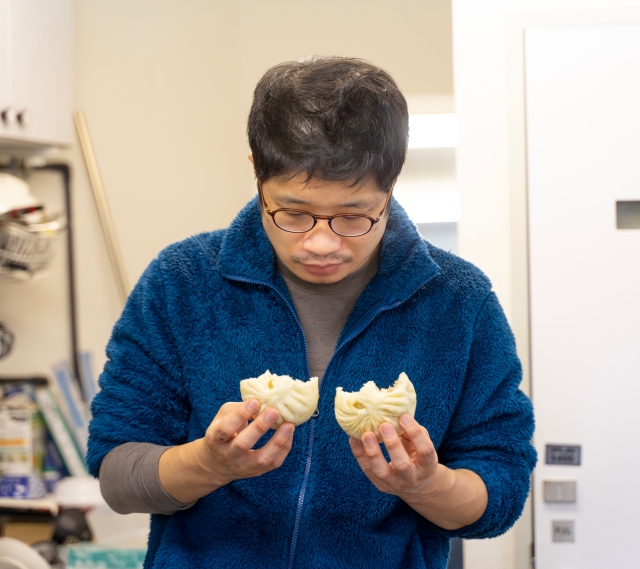
 We take a giraffe nap in a standing sleep pod at a cafe in Tokyo
We take a giraffe nap in a standing sleep pod at a cafe in Tokyo Tokyo taking a stand on walking up and down escalators
Tokyo taking a stand on walking up and down escalators Japanese readers rave about new book illustrating differences between Kanto and Kansai regions
Japanese readers rave about new book illustrating differences between Kanto and Kansai regions The best cosplayers from Day 1 of Summer Comiket 2023【Photos】
The best cosplayers from Day 1 of Summer Comiket 2023【Photos】 Fast-food chain Gyoza no Ohsho’s all-you-can-eat curry made us feel like we fell down a mountain
Fast-food chain Gyoza no Ohsho’s all-you-can-eat curry made us feel like we fell down a mountain Tokyo Tsukiji fish market site to be redeveloped with 50,000-seat stadium, hotel, shopping center
Tokyo Tsukiji fish market site to be redeveloped with 50,000-seat stadium, hotel, shopping center Japanese ramen restaurants under pressure from new yen banknotes
Japanese ramen restaurants under pressure from new yen banknotes Pokémon Sleep camping suite and guestrooms coming to Tokyo Hyatt along with giant Snorlax burgers
Pokémon Sleep camping suite and guestrooms coming to Tokyo Hyatt along with giant Snorlax burgers French Fries Bread in Tokyo’s Shibuya becomes a hit on social media
French Fries Bread in Tokyo’s Shibuya becomes a hit on social media McDonald’s new Happy Meals offer up cute and practical Sanrio lifestyle goods
McDonald’s new Happy Meals offer up cute and practical Sanrio lifestyle goods Beautiful Red and Blue Star luxury trains set to be Japan’s new Hokkaido travel stars
Beautiful Red and Blue Star luxury trains set to be Japan’s new Hokkaido travel stars Sakura tree falls on man at Sannenzaka near Kiyomizu temple in Kyoto 【Breaking News】
Sakura tree falls on man at Sannenzaka near Kiyomizu temple in Kyoto 【Breaking News】 New private rooms on Tokaido Shinkansen change the way we travel from Tokyo to Kyoto
New private rooms on Tokaido Shinkansen change the way we travel from Tokyo to Kyoto We tried Korea’s way-too-big King Tonkatsu Burger at Lotteria 【Taste Test】
We tried Korea’s way-too-big King Tonkatsu Burger at Lotteria 【Taste Test】 Mt. Koya planning to instate visitor’s tax to cope with huge tourist numbers
Mt. Koya planning to instate visitor’s tax to cope with huge tourist numbers All-you-can-drink Starbucks and amazing views part of Tokyo’s new 170 meter-high sky lounge
All-you-can-drink Starbucks and amazing views part of Tokyo’s new 170 meter-high sky lounge More foreign tourists than ever before in history visited Japan last month
More foreign tourists than ever before in history visited Japan last month Starbucks reopens at Shibuya Scramble Crossing with new look and design concept
Starbucks reopens at Shibuya Scramble Crossing with new look and design concept Studio Ghibli releases new action figures featuring Nausicaä of the Valley of the Wind characters
Studio Ghibli releases new action figures featuring Nausicaä of the Valley of the Wind characters Studio Ghibli glasses cases let anime characters keep an eye on your spectacles
Studio Ghibli glasses cases let anime characters keep an eye on your spectacles Is the new Shinkansen Train Desk ticket worth it?
Is the new Shinkansen Train Desk ticket worth it? Beautiful Ghibli sealing wax kits let you create accessories and elegant letter decorations【Pics】
Beautiful Ghibli sealing wax kits let you create accessories and elegant letter decorations【Pics】 Studio Ghibli releases Kiki’s Delivery Service chocolate cake pouches in Japan
Studio Ghibli releases Kiki’s Delivery Service chocolate cake pouches in Japan New definition of “Japanese whiskey” goes into effect to prevent fakes from fooling overseas buyers
New definition of “Japanese whiskey” goes into effect to prevent fakes from fooling overseas buyers Our Japanese reporter visits Costco in the U.S., finds super American and very Japanese things
Our Japanese reporter visits Costco in the U.S., finds super American and very Japanese things Studio Ghibli unveils Mother’s Day gift set that captures the love in My Neighbour Totoro
Studio Ghibli unveils Mother’s Day gift set that captures the love in My Neighbour Totoro Domino’s Japan now sells…pizza ears?
Domino’s Japan now sells…pizza ears? New Japanese KitKat flavour stars Sanrio characters, including Hello Kitty
New Japanese KitKat flavour stars Sanrio characters, including Hello Kitty New Pokémon cakes let you eat your way through Pikachu and all the Eevee evolutions
New Pokémon cakes let you eat your way through Pikachu and all the Eevee evolutions Sales of Japan’s most convenient train ticket/shopping payment cards suspended indefinitely
Sales of Japan’s most convenient train ticket/shopping payment cards suspended indefinitely Sold-out Studio Ghibli desktop humidifiers are back so Totoro can help you through the dry season
Sold-out Studio Ghibli desktop humidifiers are back so Totoro can help you through the dry season Japanese government to make first change to romanization spelling rules since the 1950s
Japanese government to make first change to romanization spelling rules since the 1950s Ghibli founders Toshio Suzuki and Hayao Miyazaki contribute to Japanese whisky Totoro label design
Ghibli founders Toshio Suzuki and Hayao Miyazaki contribute to Japanese whisky Totoro label design Doraemon found buried at sea as scene from 1993 anime becomes real life【Photos】
Doraemon found buried at sea as scene from 1993 anime becomes real life【Photos】 Tokyo’s most famous Starbucks is closed
Tokyo’s most famous Starbucks is closed One Piece characters’ nationalities revealed, but fans have mixed opinions
One Piece characters’ nationalities revealed, but fans have mixed opinions We asked a Uniqlo employee what four things we should buy and their suggestions didn’t disappoint
We asked a Uniqlo employee what four things we should buy and their suggestions didn’t disappoint Princesses, fruits, and blacksmiths: Study reveals the 30 most unusual family names in Japan
Princesses, fruits, and blacksmiths: Study reveals the 30 most unusual family names in Japan We try Keiji, an incredibly rare and expensive one-in-ten-thousand salmon sushi 【Taste test】
We try Keiji, an incredibly rare and expensive one-in-ten-thousand salmon sushi 【Taste test】 Random beef tongue vending machine in Tokyo lets us test our luck, fill our bellies【Taste test】
Random beef tongue vending machine in Tokyo lets us test our luck, fill our bellies【Taste test】 Japanese bento serves up a slice of the samurai life in a special carry case
Japanese bento serves up a slice of the samurai life in a special carry case Saitama officially forbids walking up and down escalators
Saitama officially forbids walking up and down escalators Why do seats at some Japanese station platforms face away from the trains?
Why do seats at some Japanese station platforms face away from the trains? Kyoto in summer: A special trip to Kifune shrine recharges the soul
Kyoto in summer: A special trip to Kifune shrine recharges the soul Our reporter dishes on the differences between sushi from Ginza Kyubey and Sushiro【Taste test】
Our reporter dishes on the differences between sushi from Ginza Kyubey and Sushiro【Taste test】 Starbucks Oleato in Japan: Staff note reveals the best thing to drink it with
Starbucks Oleato in Japan: Staff note reveals the best thing to drink it with Mos Burger vs Burger King: Which chip butty is better?
Mos Burger vs Burger King: Which chip butty is better? Chocolate Mint drink with 10 times the minty refreshment: Is it really as strong as it looks?
Chocolate Mint drink with 10 times the minty refreshment: Is it really as strong as it looks? 4 things that surprised us about Japan’s completely unmanned, 24-hour meat shop
4 things that surprised us about Japan’s completely unmanned, 24-hour meat shop Japanese restaurant combines solo shabu shabu dining with the fun of a sushi train
Japanese restaurant combines solo shabu shabu dining with the fun of a sushi train Our Japanese writer discovers a surprising escalator in the US, declares America Best Place Ever
Our Japanese writer discovers a surprising escalator in the US, declares America Best Place Ever Japanese escalator cleaning crew discovers an absurd amount of change
Japanese escalator cleaning crew discovers an absurd amount of change Tokyo farewells Japan’s only double-decker Shinkansen with a special escalator at the station
Tokyo farewells Japan’s only double-decker Shinkansen with a special escalator at the station We try some “raw” dorayaki from Kyoto and are overwhelmed with its thickness
We try some “raw” dorayaki from Kyoto and are overwhelmed with its thickness
Leave a Reply